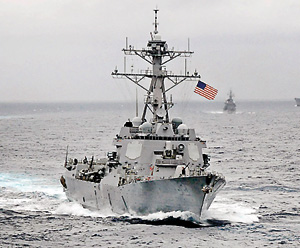Confrontation or not, challenge China in South seas
LONDON – The sailing of a US warship within 12 miles of one of China’s new artificial islands in the South China Sea represents the most daring American military intervention in years. Not since President Bill Clinton sent a naval group through the Taiwan Strait in 1996 as a supportive gesture to the then-beleaguered Taiwanese has the United States so boldly defied China’s unlawful territorial claims.

The US warship came within 12 nautical miles of the artificial islands built by China (Reuters)
As a symbolic gesture, the move is welcome. But it is not enough. If China’s interpretations of international law – which invariably serve its expansionist ambitions -are truly to be countered, challenges of its territorial claims will need to be repeated regularly and coordinated with others.
China’s response to the intervention was to feign outrage, describing it as an illegal intrusion into its sovereign waters and a sign of American hypocrisy; the United States cares when China builds artificial islands in the South China Sea, the Chinese argue, but not when Vietnam or the Philippines do the same. But neither argument holds water, as the Chinese know perfectly well.
Neither Vietnam nor the Philippines has laid claim to the whole of the South China Sea, as China does through the notorious “nine-dash line” – a huge tongue-shaped territorial claim first put forward after World War II by the Chinese Nationalist government and later embraced by the Communists.
Nor has either country violated the United Nations Convention on the Law of the Sea by claiming sovereignty over waters surrounding what were previously submerged rocks. Only by ignoring the Convention’s strict definitions can one describe the US intervention as “illegal,” and even then it is not clear under what law it would be prohibited.
In fact, such arguments are mere window dressing. There is one perspective from which China’s attitude to territorial disputes in the South China Sea makes perfect sense. For centuries, China was by far the region’s largest and most powerful country, holding sway over the surrounding seas and treating most of its neighbors as inferior, vassal states. After a gap of two in which China was atypically weak, it is rapidly regaining power, and now wants to restore what it sees as the old order in East Asia.
Put another way, China is becoming the sort of superpower that feels entitled to control the sea, land, and air around its territory – just like the US. China is aspiring to become the equal of the US, one of the world’s two dominant superpowers. As a result, its leaders believes that China ought to be able to project military power and defend what it regards as its strategic space – just like the US.
This would not be difficult to understand – nor would it necessarily be unreasonable – if other countries were not involved. The US certainly exhibits a certain sense of entitlement in the way it treats its neighbors. But neither Canada nor Mexico currently feel encroached upon or bullied in the way that many of the countries surrounding China do.
Nor do US strategic considerations threaten the free flow of international trade and shipping. China’s certainly could. And even if one does regard the US and hina as coequal superpowers, it is important to note that the US has wider international support and acceptance. This might change in the future; but, for the time being, it is a reality.
There can be no doubt that China will keep pushing forward, attempting to create more “facts on the ground” to back up its sovereignty claims. The only way to oppose it, at least by peaceful means, is by consistently demonstrating that its claims are not recognized. Its “facts” must be shown to be nothing more than opinions.
That will require regular interventions, in the form of journeys by all sorts of vessels, both military and commercial – ideally under many national flags – through the waters China is attempting to claim. That is, after all, the tactic China itself has been using in the East China Sea, where it has been sending fleets of boats through the waters around the Japanese Senkaku islands, which China calls the Diaoyu.
China’s actions in Japanese waters may be illegal, but they make their point (and underline it almost daily). The US and its allies must do the same in the South China Sea. Doing so will risk accidental collisions and confrontations. But doing nothing, or making only isolated gestures, will simply hand China a fait accompli.
(Bill Emmott is a former editor-in-chief of The Economist.) Courtesy : Project Syndicate, 2015. Exclusive to the Sunday Times. www.project-syndicate.org


